Film Description (CUFF)
This Sundance-selected ambient slasher from Canadian filmmaker Chris Nash (Z IS FOR ZYGOTE) methodically depicts the enigmatic resurrection, rampage, and retribution of an undead monster in the remote wilderness. When a locket is removed from a collapsed fire tower in the woods that entombs the rotting corpse of Johnny, a vengeful spirit who was the victim of a horrific 60-year-old crime, his body is resurrected, and he’s hell-bent on retrieving what’s his. The undead golem hones in on the group of vacationing teens responsible for the theft, and in his mission to get the locket back proceeds to methodically slaughter them one by one, along with anyone in his way. One of the few slasher films to be shot from the killer’s POV, IN A VIOLENT NATURE is a modern Canadian horror classic in the making.
Trailer
Chris Nash
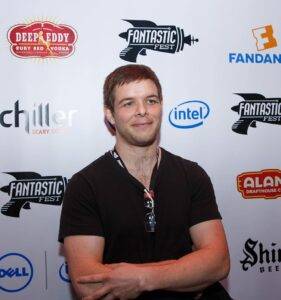
Chris Nash is a writer, director, and prosthetics effects artist from Sault Ste. Marie, Ontario. His journey into filmmaking was influenced by a steady diet of 7/7/7 video rentals (seven movies, seven days, seven dollars – excluding new releases) and incredibly curated and unedited late-night movies airing Monday to Saturday on CBC television at 1:00am. His short films and music videos have screened internationally, and in 2014 his short Z IS FOR ZYGOTE was selected to close off the horror anthology, THE ABCS OF DEATH 2. IN A VIOLENT NATURE is his first feature film.
Review of the Film
In my conversation with In a Violent Nature director Chris Nash, he shines some light on the filmmaking experience, from the surprisingly smooth pre-production process, through having to reshoot 70% of the film, to dealing with the inescapable imposter syndrome.
A Conversation with Chris Nash: Director of IN A VIOLENT NATURE
On Breaking Conventions and Reshooting the Entire Film
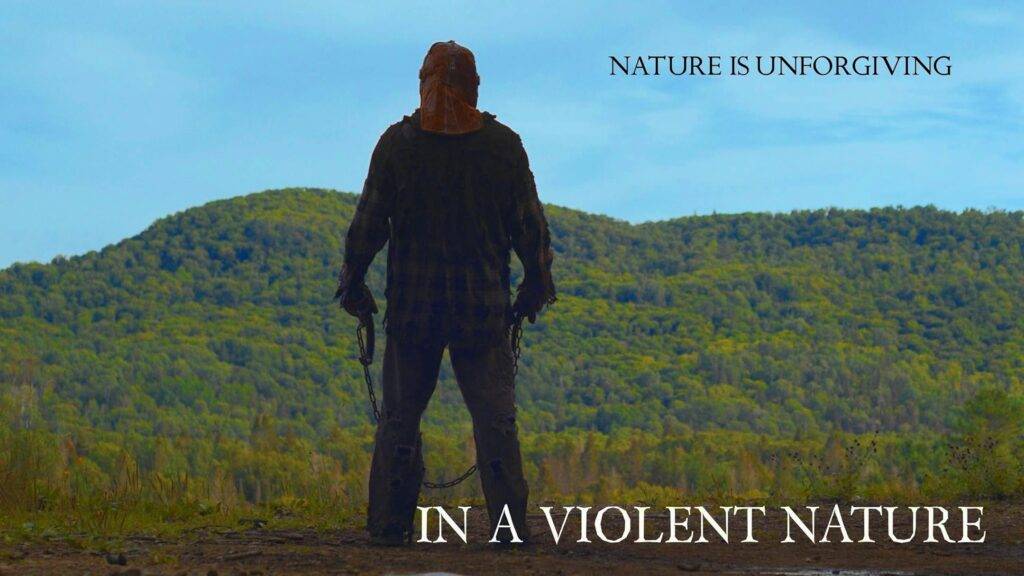
Adam Manery
With In a Violent Nature, there’s a clear subversion of the classic slasher genre, where we have this shift of perspective. Essentially, we follow the killer in every frame of the film (up to a point) rather than the “victims,” which is different from the prototypical slasher. Was this a difficult pitch?
Chris Nash
Surprisingly, it was remarkably easy. There were a lot of things that we thought we were going to brush up against. For example, we wanted to shoot it in a 4:3 aspect ratio. We wanted to tap into how I felt watching the Friday movies as a kid. We didn’t watch them in widescreen in 4K. We watched them on a crappy VHS on a CRT TV with color all over the place, and everything’s way too green.
We thought we would get pushback on that, so we shot it to be a widescreen frame, but we always had our borders on to know what we wanted for a frame and hoped that we wouldn’t get any resistance. And we didn’t. From the start, the response was always, “Yeah, that’s okay.”
We also didn’t want a musical score, and the reply was, “Yeah, sure. Whatever you’re feeling, go for it.” It started feeling too easy. We kept thinking we would brush up against something and would have resistance at some point, but we didn’t. I think a lot of that also had to do with the fact that we had just finished making my friend Steve Kostanski’s film, Psycho Goreman, and we had a lot of the same crew who would be working on this project.
Having that precedent be set provided some faith that it’ll get done. In A Violent Nature isn’t an experimental film, but the film itself is an experiment. Is this going to work? We don’t know. That’s every film in some ways, but we were still lucky that they were game the whole time. It was very, very surprising.
We reshot 70% of the film… We did four weeks of shooting in a completely different location with a different lead actor who succumbed to a medical problem a week and a half into the production. So we had to replace our main “monster man” actor.
AM
That’s amazing. While you didn’t have any roadblocks during pre-production, I have heard stories about the chaos of the actual production process. You essentially shot this film twice, right? Can you walk me through that?
CN
That wouldn’t be a walk. It would be a hike through the mountains. An overnight trip. Actually, it would take the whole weekend.
So yeah, we had some hurdles. I would say that we reshot 70% of the film. That number fluctuates depending on my mood, but it’s around 70%. We did four weeks of shooting in a completely different location with a different lead actor who succumbed to a medical problem a week and a half into the production. So we had to replace our main “monster man” actor. He’s in a costume the entire film, so I thought if we could find somebody the same size, same build, roughly, then we could get away with making the change.
But there are so many important things about performance. How they carry themselves, the gait of their walk, the weight of their footfalls; all of that mattered so much. We only realized how much that mattered once we did a rough assembly of those first four weeks and could see the stark differences. They’re almost imperceptible until you realize that this is really the entire movie. It’s just watching somebody walk and move and studying their behavior. But that was only one of the reasons we felt it necessary to pick up production and start again completely.
Another, perhaps more selfish, reason was that I’d always envisioned this to be shot in Northern Ontario using that wilderness. That’s where I’m from, and where we were initially shooting didn’t have the same feeling.
The trees didn’t feel the same. Everything felt different and too uncanny for what I wanted. Having the opportunity to reshoot, I was adamant with my producing partners that I would love to return to my hometown and call in every favor I could from every friend and family member. It’s not like we had the same budget to work with to get it all done, and luckily, a lot of our crew stuck with us. A lot of our actors stuck with us, and we managed to pull it all together.
There is one shot from the original film. It’s a five or six-second shot that was included, and it’s the most expensive shot in the film by far
AM
Hey, it worked out. Your producers sound like angels. Not all production teams would be that open.
CN
My producers are my best friends. I’ve known Peter Kuplowsky for 15 years, and I’ve known Shannon Hanmer for 20 years. They understand all my idiosyncrasies and my neuroses more than anybody. They’re saints – just saintly people.
On Collaboration and Premiering at Sundance
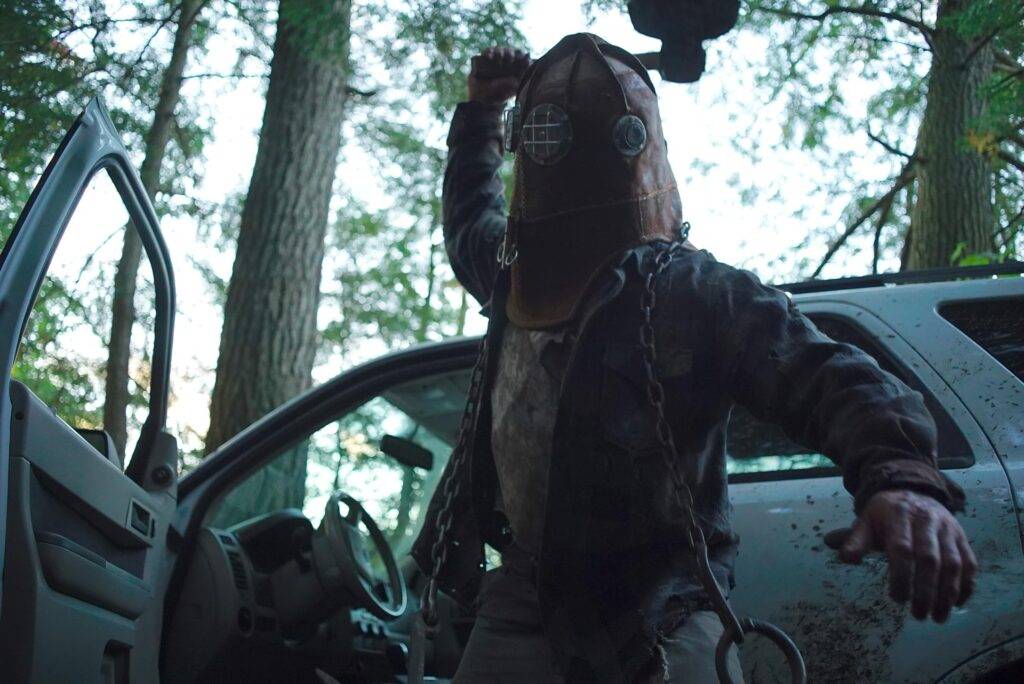
AM
You mentioned how you called in every favor and worked with many of your friends. One of your long-time collaborators, Pierce Derks, was asked to take on the role of Director of Photography. What is the history of this collaboration, and what was that change like?
CN
It only came about after we did interviews for this film, during which we actually had to think back about how long we have known each other and how we even met. I have no idea. Pierce and I have no idea where we met. It was just through this osmosis of the genre film community in Toronto.
Pierce, Shannon, Peter, and I have all worked together for years and years at this point. He’s always been there. Shannon, Pierce, and I have shot some music videos together for Shannon’s brother’s band, The Birthday Massacre, and we’ve also just worked on short projects together. However, for this one, initially, our director of photography was Andrew Appelle, who shot Psycho Goreman.
After those first four weeks, while we were trying to reconvene and reassess what we would do, he was offered to direct a couple of seasons of the documentary series “Dark Side of the Ring.” He just couldn’t pass it up, so he had to take it. That was unfortunate for the production, But Pierce was on board those first four weeks shooting behind the scenes. He was our behind-the-scenes documentarian.
Boy, oh boy, is there a documentary in there somewhere. Pierce was there firsthand, and he understood what we were doing and what we were going for. When Andy couldn’t return, he said he’d step in and do it.
We were so happy to have him there. It definitely has a different feel than we originally had, but that was also because our budget had shrunk considerably. We couldn’t have many of the toys we originally had on set, so it had to be a much more torn-down shoot, a lot more rugged. He delivered completely. I couldn’t be happier.
AM
It’s one of those things where everything goes wrong, but it all works out. It premiered at Sundance, which is many indie directors’ dream. What was what was the experience like?
CN
It would be a lot different if I was 25 years old and had my first feature there. Being a little older and a little more mature, I don’t feel the need to go to parties or do anything. I was much more excited to go out and explore Utah. That said, I don’t want to seem ungrateful.
It may be just the imposter syndrome that is still running through my body. Of not feeling like you deserve it. But still, it was great. We didn’t know how anybody was going to respond to the film. We seriously thought we were making it for maybe five people, that it would go to streaming, and that it would be like a nice stepping stone to show that we could make a film and move on to the next project. So, getting into Sundance came out of nowhere. We were in a state of disbelief. We did that. Honestly, I think I’m still processing the journey this film has been on.
On Reading Reviews and Making Creative Decisions
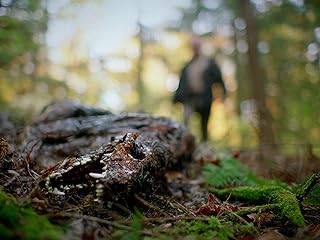
AM
On the imposter syndrome note, do you read reviews? I’ve read a few, including some that compare your direction to Terrence Malick. That would be enough to trigger a case of imposter syndrome.
CN
Yes and no. I will read critical reviews, but I’m not on Letterboxd at all. Letterboxd’s slogan should be, “Everyone’s a Critic,” and not everyone should be.
I think that being in the state I am and being a little older, I’m not really on social media. I try to avoid it. I did have to give my family a primer, letting them know to avoid digging too deep into reviews. Don’t think too much of it. Definitely don’t read the comments.
Some people aren’t going to like this movie. It’s not going to be their cup of tea. We understand that. It’s not for everybody. It’s a vibe, it’s a tone more than anything. I go into everything knowing that.
A lot of the reviews that haven’t been so favorable, you’re also reading them and see the valid points. Yeah, the characters weren’t developed. Completely valid. If that’s your criticism, and that’s the kind of movie you wanted to see, I can understand why you would be disappointed with seeing our movie. Everything’s been fair. I feel like every bit of criticism, good or bad, has been fair, and points I can’t argue with. At least, most of them are criticizing the movie they saw rather than the one they wanted to see.
That scene was so “creatively masturbatory” from a directing standpoint. What are you doing? You might as well be pointing the camera at yourself, like, “See what I did?”
AM
You have to approach it like that. It isn’t a movie for everyone. The pacing is different than some folks might expect. You’ve made several creative decisions, with the 4:3 aspect ratio and the lack of score. Were there any other creative ideas you wanted to explore that ultimately were pushing it too far? Or did your complete creative vision come to life?
CN
For the most part, it is exactly what we wanted to do. Still, we had some things in mind, like a lake death scene we originally conceived as a much more elaborate shot. We were going to have the camera travel over the top of the water, and everything would be one big, unbroken take. And logistically, there were just way too many issues with that. We made concessions, we kept attempting, and things just went wrong one after another.
We got to a point where we had to go very, very minimalist and lock off the camera in one corner and shoot it much differently than we originally conceived. It made us re-examine what the film is and what the tone is, and even thinking back at it, the original conception of how we would shoot that scene was so “creatively masturbatory” from a directing standpoint. What are you doing? You might as well be pointing the camera at yourself, like, “See what I did?”
Things like that actually helped the film. The final scene was also supposed to be a giant set piece with buildings lit on fire and just death incarnate. That was proving to be a lot to handle, and many things were going wrong. And at this point, we didn’t really have a set building crew or anything like that. So, all of it was falling into the hands of my friends and me. Time was running out, and things were getting stressful.
I was talking with one of my friends, Nate Wilson, an incredibly talented filmmaker who was the AD for a portion of this film. He asked if I had any other ideas for how I wanted to end it. I was just so frustrated. I said that maybe it should have a very unceremonious, aggressive, and even funny ending. Have the ending be something people don’t expect and not tied up in a nice bow like everybody wanted it to be.
He thought it was a great idea. We were playing enough with genre and slasher conventions at that point. If we did try to end it with the original set piece, it would just become another slasher film. Which isn’t bad, but it definitely wasn’t what we were trying to do. It definitely wasn’t our film. All these things that didn’t go right—I feel like in the end, there’s a reason they didn’t go right.
You know, cosmic milieu in the universe knows what’s supposed to happen and what isn’t. So you just have to keep trying, but it’ll figure itself out.
On Choosing Johnny’s Mask and Attending CUFF

AM
This is the film you had to make. Shifting gears – I love Johnny’s mask. It’s an old firefighter mask, right? How did you land on that?
CN
Yeah, it’s based on an old firefighting mask—a turn-of-the-century leather mask used as an air recirculation “thing.” It looks like a diving bell. The original masks were much larger. We actually had somebody build the mask for the original shoot who made a fantastic replica.
It was exactly what I asked for, but it was just a little too goofy-looking because it felt like a diving bell. We had to redesign it and make it a little more form-fitting. So it’s not exactly the same design. We had to tweak it to make it a little more intimidating. But you’re right; it’s based on an old firefighting mask. I always liked the mask.
I originally saw it in a cracked.com article about creepy or interesting devices. As soon as I saw it, I thought about how it could be used in a horror movie. How terrifying it would be to be caught in a fire and the one person who’s supposed to save you is an alien.
So that was always in the back of my head. I felt like this was a perfect opportunity to use it because it tied in with the mythology of the killer and the landscape and the environment. It was another perfect coincidence where everything works together.
AM
Before I let you go, are there any films you’re looking forward to catching while you’re at CUFF?
CN
I will check out some films, but unfortunately, I’ll only be there for a day and a half. We’re in pre-production on Steve Kostanski’s newest film, so I’m in and out quickly. At every festival, though, I check out the shorts program. That’s the one thing I always make a point to check out. If you want to know what’s coming up in the film landscape, shorts programs are the way to go.
Tickets are still available to watch In a Violent Nature at CUFF
You can find more interviews here
You can find film reviews here

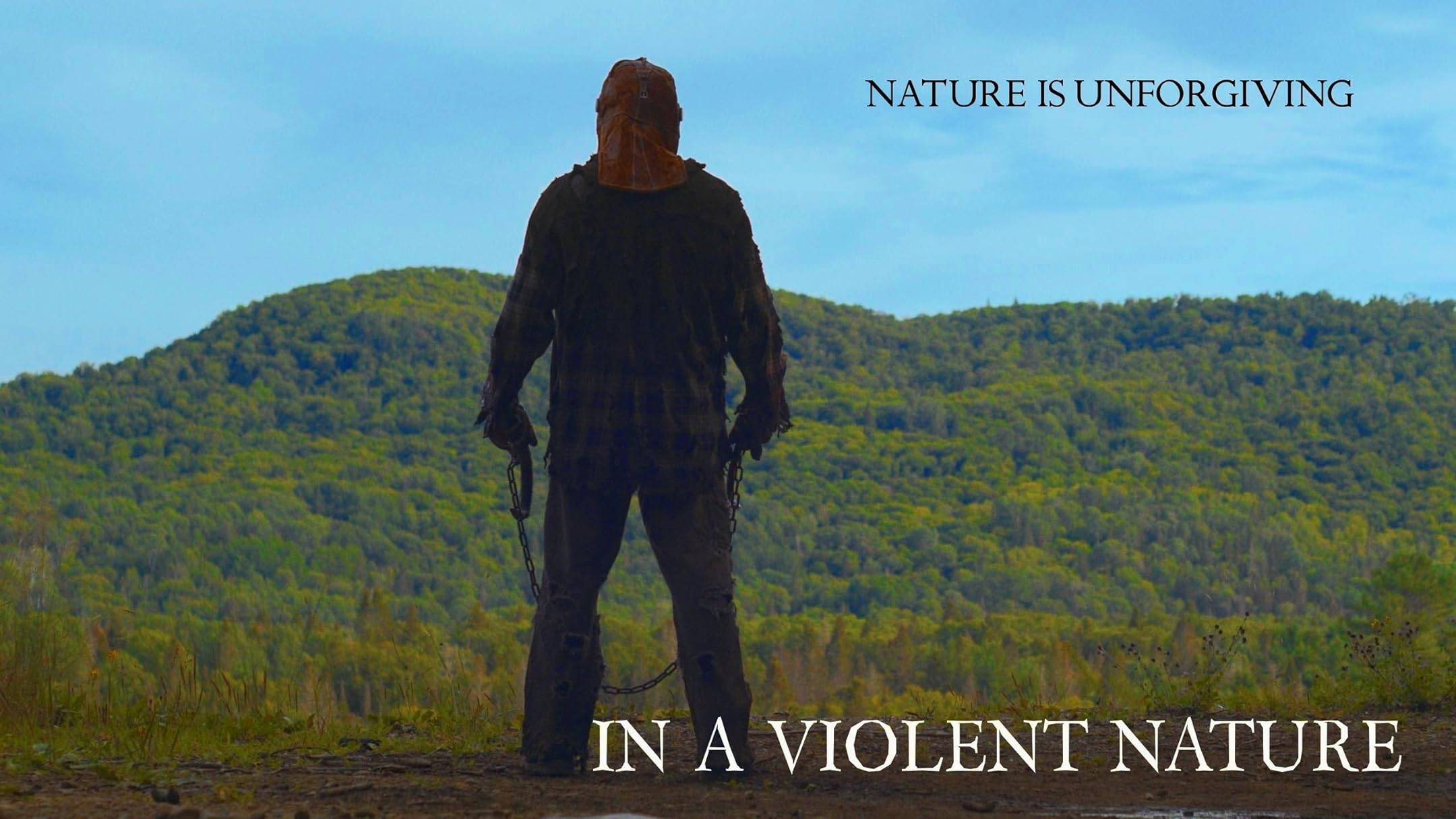



Pingback: In a Violent Nature: Conoce todo sobre el nuevo fenómeno del terror
Pingback: In a Violent Nature Film Review (with Director Chris Nash)
Pingback: De naturaleza violenta – La abadía de Berzano